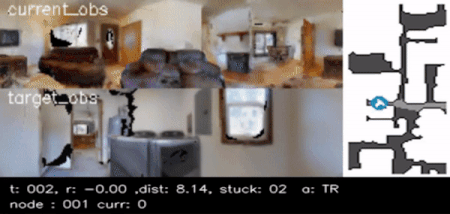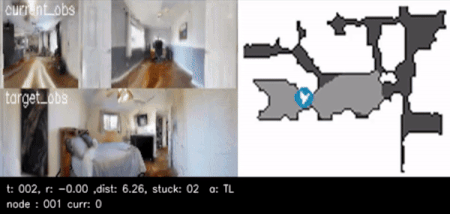This is an official GitHub Repository for paper "Visual Graph Memory with Unsupervised Representation for Visual Navigation", which is accepted as a regular paper (poster) in ICCV 2021.
The source code is developed and tested in the following setting.
- Python 3.6
- pytorch 1.4~1.7
- habitat-sim 0.1.7 (commit version: ee75ba5312fff02aa60c04f0ad0b357452fc2edc)
- habitat 0.1.7 (commit version: 34a4042c03d6596f1d614faa4891868ddaf81c04)
Please refer to habitat-sim and habitat-lab for installation.
To set the environment, run:
pip install -r requirements.txt
Most of the scripts in this code build the environments assuming that the gibson/mp3d dataset is in habitat-lab/data/ folder.
The recommended folder structure of habitat-api (or habitat-lab):
habitat-api (or habitat-lab)
└── data
└── datasets
│ └── pointnav
│ └── gibson
│ └── v1
│ └── train
│ └── val
└── scene_datasets
└── gibson_habitat
└── *.glb, *.navmeshs
otherwise, you should edit the data path in these lines.
To visualize the VGM generation, run:
python vgm_demo.py --gpu 0 --num-proc 2
This command will show the online VGM generation during random exploration. The rendering window will show the generated VGM and the observations as follows:
Note that the top-down map and pose information are only used for visualization, not for the graph generation.
- Data generation
This will generate the data for imitation learning. You can find some examples of the collected data in IL_data folder, and look into them with show_IL_data.ipynb.
python collect_IL_data.py --ep-per-env 200 --num-procs 4 --split train --data-dir /path/to/save/data - Training
python train_bc.py --config configs/vgm.yaml --stop --gpu 0 - Evaluation
The reinforcement learning code is highly based on habitat-lab/habitat_baselines. To train the agent with reinforcement learning (PPO), run:
python train_rl.py --config configs/vgm.yaml --version EXPERIMENT_NAME --diff hard --render --stop --gpu 0
We provide evaluation code and the pretrained model.
python evaluate_random.py --config configs/vgm.yaml --version-name test --eval-ckpt VGM_ILRL.pth --stop --diff hard
You can use "evaluate_dataset.py" to evaluate VGM on public image-goal nav dataset (https://github.com/facebookresearch/image-goal-nav-dataset)
git clone https://github.com/facebookresearch/image-goal-nav-dataset.git
python evaluate_dataset.py --config configs/vgm.yaml --version-name test --eval-ckpt VGM_ILRL.pth --stop --diff hard
In the above dataset, the provided pretrained model shows following performances.
| Easy(SR) | Easy(SPL) | Medium(SR) | Medium(SPL) | Hard(SR) | Hard(SPL) | Overall(SR) | Overall(SPL) |
|---|---|---|---|---|---|---|---|
| 0.76 | 0.40 | 0.76 | 0.56 | 0.62 | 0.49 | 0.71 | 0.48 |

